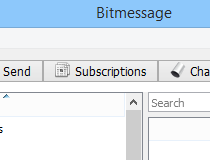
#BITMESSAGE VS GENERATOR#
The quality of the number generator contributes to the randomness and security of the ciphertext, however. Placing this seed value into a cryptographic number generator, Person A can create a pseudo-random keystream that matches the size of their desired plaintext file. To do that, they must first use an initialization vector ( IV) to generate a random seed value. Here, Person A decides to use a 4-bit key to encrypt a 10-bit message. Furthermore, to avoid having to create a larger keystream, users can use a cryptographic number generator to create a larger keystream from a smaller, pseudo-random key.

This is because Person A could opt to create a pseudo-random cipher digit stream, or keystream, using a key that is smaller than the size of the plaintext file. This can become cumbersome depending on the size of the message or document they are attempting to encrypt, however.Ĭryptographers also refer to the symmetric key used in a stream cipher as a keystream. The one-time pad, in this case, would also be at least 10 bits long. Here is an example to illustrate the one-timed pad process of stream ciphering: Person A attempts to encrypt a 10-bit message using a stream cipher. A stream cipher is a cryptographic cipher to convert (encrypt) text to produce ciphertext and back. Mathematically, a one-time pad is unbreakable because it's always at least the exact same size as the message it is encrypting. The key typically used with a stream cipher is known as a one-time pad. This makes for a fast and relatively simple encryption process.īasic encryption requires three main components: What makes stream ciphers particularly unique is that they encrypt data one bit, or byte, at a time. Asymmetric keys will sometimes use one key to encrypt a message and another to decrypt the respective ciphertext.

A symmetric cipher key, as opposed to an asymmetric cipher key, is an encryption tool that is used in both encryption and decryption. How does a stream cipher work?Ī stream cipher is an encryption algorithm that uses a symmetric key to encrypt and decrypt a given amount of data. The main alternative method to stream cipher is, in fact, the block cipher, where a key and algorithm are applied to blocks of data rather than individual bits in a stream. A stream cipher is a method of encrypting text (to produce ciphertext) in which a cryptographic key and algorithm are applied to each binary digit in a data stream, one bit at a time.


 0 kommentar(er)
0 kommentar(er)
